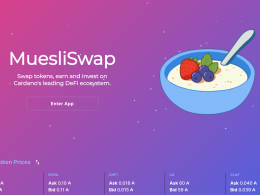Spectrum Finance is an open source, multi-chain Decentralized Exchange (DEX) for cross-chain swaps, providing liquidity, and liquidity mining.
The DEX is being built on the Spectrum Network, which is a multi-chain network that offers interoperability for DeFi.
The app is currently working on the Cardano and Ergo blockchain.
Spectrum Finance originated as an Automated Market Maker (AMM) protocol called ErgoDEX on the Ergo blockchain.
I wrote, a while ago, an extensive article on ErgoDEX, in two parts, which you can find at the end of this article.
Recognizing the global issue of lack of interoperability within the DeFi space, the development team made the decision to expand the project to a decentralized cross-chain exchange.
This expansion was made possible by the creation of a self-developed cross-chain smart contract platform known as Spectrum Network.
You can see in Github its code.
What Is Spectrum Finance?
It is essential to establish clear differences between the different aspects of Spectrum:
—Spectrum Finance: a brand name of the cross-chain decentralized exchange (DEX)
—Spectrum Finance Ergo AMM: a set of ErgoScript smart contracts which implement Uniswap v2 like AMM protocol on top of Ergo Layer 1 blockchain
—Spectrum Finance Cardano AMM: a set of Plutus smart contracts which implement Uniswap-v2-like AMM protocol on top of the Cardano Layer 1 blockchain
—Spectrum Finance: a set of smart contracts which implement Uniswap-v2-like AMM protocol on top of Spectrum Network
—Spectrum Network (Spectrum Protocol): a cross-chain smart-contract platform for building natively cross-chain dApps
—Spectrum Finance User Interface (UI): a web (or mobile) interface which provides user-friendly access to the protocols
—Spectrum Labs: the team of developers who are developing and maintaining Spectrum Finance protocols, its components, user interface and other products
Let’s look at some of the opportunities this development presents:
Cross-chain Decentralized Exchange
Spectrum Network is a smart contract platform for programmable messaging across blockchains. Its architecture allows developers to seamlessly interact with native currencies and tokens across multiple blockchains simultaneously.
This allows them to create decentralized applications (DApps) that operate natively in a cross-chain environment. Consequently, for example, there will be no need for wrapped or synthetic assets, when executing actions such as exchanging native ETH on the Ethereum mainnet to native ADA on the Cardano mainnet.
The protocol reduces contract gas fees by using batches of proven transactions that can be settled in a single block on the Layer 1 blockchain. This not only improves the speed of order execution, but also contributes to a notable reduction in gas commissions.
Cross-chain Lending Protocol
One of Spectrum Finance’s goals is to simplify the investment offered by other chains. For example, an Ethereum investor currently faces limitations in participating in opportunities on other blockchains without resorting to centralized exchanges. To take advantage of a DeFi opportunity in the Cardano ecosystem, the user would have to transfer their ETH to a centralized exchange, convert it to a stablecoin, convert the stablecoin to ADA, and finally withdraw the ADAs from the exchange.
Cross-chain lending will alter these restrictions by allowing direct lending of ADA against ETH. This will allow users to use ADA within the Cardano DeFi ecosystem and take advantage of various DeFi opportunities while retaining their entire ETH position.
Cross-chain Yield Aggregator
Like other traditional DeFi applications, current yield aggregators are constrained by the limitations of the ecosystems in which they operate. This restriction leads to a significant loss of opportunities that other networks would otherwise be able to access. Spectrum Network presents a solution by offering decentralized applications (DApps) the opportunity to implement borderless performance strategies by incorporating native assets from different blockchain networks.
Cross-chain NFTs
Adopting a cross-chain NFT marketplace presents a compelling option for artists as it offers several advantages.
Additionally, the Spectrum Protocol creates opportunities for projects focused on digital identity development. It facilitates the use of a unified digital identity across several blockchain networks connected to the Protocol. This capability streamlines the management and use of digital identities, providing greater convenience and interoperability.
You can read its complete White paper.
The Manifesto
Very few developments have published a manifesto, that is, a declaration of principles and the mission that the founders seek, and this is very typical of the philosophy of Ergo blockchain.
The principles of Spectrum Finance:
- Decentralization: No component or protocol should have central control.
- Trustlessness: The element of trust must be eliminated.
- Permissionlessness: Any person should be able to use the protocol when connected to the Internet.
- Security: The protocol must not have vulnerabilities that compromise participants’ assets.
- Open source code: The protocol’s source code must be available to everyone.
The Tokenomics
On December 25, 2022, 1 billion SPF, the protocol’s utility token, was minted. 50% will be accessible over 3 years on the Ergo and Cardano networks. The remaining 50% will be distributed among Spectrum Network cross-chain protocol validators.
75.4% of the total supply will be distributed to the community through token sales, ISPO, Yield Farming, and Spectrum Network consensus.
The Roadmap
Spectrum Finance
- Spectrum Finance cross-chain AMM protocol testnet /In progress
- Ergo side Layer 1 AMM Protocol /Done
- Cardano side Layer 1 AMM Protocol /Done
- Spectrum Finance cross-chain AMM protocol testnet /In progress
- Spectrum Finance cross-chain AMM protocol testnet
Spectrum Network
- Spectrum Finance cross-chain AMM protocol testnet /In progress
- Spectrum Finance cross-chain AMM protocol testnet /In progress
- Spectrum Network white paper /Done
- Spectrum Network testnet /In progress
- Spectrum Network mainnet
Spectrum Finance ecosystem development
- Spectrum Finance cross-chain AMM protocol testnet /In progress
- Spectrum Finance cross-chain AMM protocol testnet /In progress
- Spectrum Finance Bug Bounty Program
- Spectrum Finance DAO & Governance
- Spectrum Finance DeFi scaling program
You can see their more detailed roadmap here.
The Team
The founders of ErgoDEX, Ilya Oskin and Yasha Black developed a secure, open-source, decentralized exchange built on the Ergo and Cardano blockchains. After more than a year building this project, in August 2022, they decided to expand the horizon by creating Spectrum Finance, the open source DEX for multi-chain swaps.
You can see the members of the team, at the end of this link (scroll down).
Ilya Oskin says in his LinkedIn that he programs in Rust, Scala, Haskell. Engineering Leader with 6 years of experience in the blockchain industry. Keen on functional programming. Took part in the development of the reference node of the eUTxO-based blockchain Ergo and its explorer.
Yasha Black is product manager, product analyst, UX/UI, and JavaScript developer with 7 years of experience in the IT industry.
The team obtained Project Catalyst funding for several proposals, which you can see here.
Website: https://spectrum.fi/
. . .










